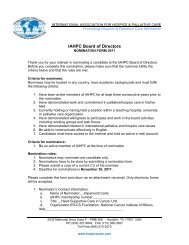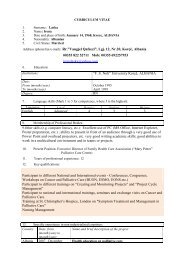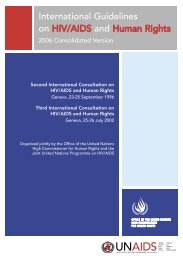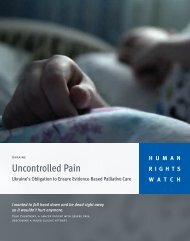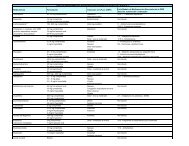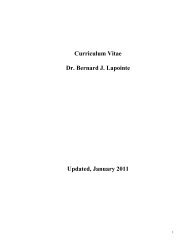INTERIGHTS Bulletin
INTERIGHTS Bulletin
INTERIGHTS Bulletin
Create successful ePaper yourself
Turn your PDF publications into a flip-book with our unique Google optimized e-Paper software.
W<br />
200 <strong>INTERIGHTS</strong> <strong>Bulletin</strong><br />
Volume 16 Number 4 2011<br />
and disease will have the effect of<br />
discouraging other persons with TB<br />
and other infectious diseases (such as<br />
HIV/AIDS) from being tested. 38<br />
Conclusion<br />
The power to detain individuals to<br />
protect the general public from health<br />
risks is open to abuse particularly<br />
because it is a popular response to<br />
health emergencies allowing politicians<br />
and civil servants to portray<br />
themselves as taking public health<br />
seriously. Society must take care that<br />
this power is used only in the most<br />
extreme cases. It is for this reason that<br />
human rights law must be given<br />
prominence in the development of any<br />
public health policy. While the<br />
Government of Kenya has emphasised<br />
the importance of patient rights it<br />
continues to rely on outdated and<br />
draconian powers of detention. There<br />
is a promise that the Government will<br />
implement community-based directly<br />
observed therapies for TB patients with<br />
isolation in pressure controlled wards<br />
in specialised hospitals only being<br />
used for exceptional cases. However,<br />
while the hospitals remain unfinished<br />
and TB patients continue to struggle<br />
with poverty and lack of social support<br />
there is a risk that detention will<br />
continue to be used in violation of the<br />
rights to liberty, freedom of movement<br />
and dignity protected under the<br />
Kenyan Constitution. Detention<br />
should be a last resort to control<br />
MDRTB but, in Kenya, it is<br />
unfortunately too easy for public<br />
health officials to obtain an order for<br />
the prolonged detention of TB patients<br />
in open prisons, where they are<br />
subjected to life threatening conditions<br />
and where they may spread the disease<br />
to vulnerable prisoners.<br />
Solomon Sacco is a lawyer at<br />
<strong>INTERIGHTS</strong>, Allan Maleche is a<br />
lawyer at the Kenya Legal & Ethical<br />
Issues Network on HIV/AIDS and<br />
Omwanza Ombati is a lawyer at<br />
Nchogu, Omwanza & Nyasimi<br />
Advocates.<br />
1 Clinicians distinguish between extremely drug resistant<br />
and multidrug resistant Tuberculosis (XDRTB and<br />
MDRTB respectively) but the distinction, although relevant<br />
to the clinical determination of which patients<br />
should be isolated, does not affect relevant human rights<br />
argument and therefore will be ignored for the purposes<br />
of this paper.<br />
2 Article 43 of the Constitution. See also Article 12 of the<br />
International Covenant on Economic, Social and<br />
Cultural Rights also ratified by Kenya.<br />
3 The right to freedom of movement in the ICCPR may<br />
be subjected to limitations ‘provided by law,…necessary<br />
to protect national security, public order (ordre public),<br />
public health or morals or the rights and freedoms of<br />
others, and…consistent with the other rights…’ The<br />
right to liberty under Article 9 of the ICCPR does not<br />
contain an overt limitation clause but reference to ‘arbitrary’<br />
detention has been interpreted to include the<br />
power to impose limitations. See Kenneth Davidson<br />
Tillman v Australia, Communication No. 1635/2007,<br />
U.N. Doc. CCPR/C/98/D/1635/2007 (2010). The<br />
Committee has emphasised however, that non-arbitrary<br />
is not be equated with ‘within the law’ and must be<br />
‘interpreted more broadly to include such elements as<br />
inappropriateness and injustice. Furthermore, remand<br />
in custody could be considered arbitrary if it is not necessary<br />
in all the circumstances of the case, for example to<br />
prevent flight or interference with evidence: the element<br />
of proportionality becomes relevant in this context.’ See<br />
A v Australia, Communication No. 560/1993, U.N. Doc.<br />
CCPR/C/59/D/560/1993 (30 April 1997) and Hugo van<br />
Alphen v The Netherlands, Communication No.<br />
305/1988, U.N. Doc. CCPR/C/39/D/305/1988 (1990).<br />
While the African Charter does not contain a general<br />
limitation clause the African Commission on Human<br />
and Peoples’ Rights has held that s 27(2) serves this<br />
purpose. See Communications 105/93-128/94-130/94-<br />
152/96: Media Rights Agenda, Constitutional Rights<br />
Project, Media Rights Agenda and Constitutional Rights<br />
Project / Nigeria, the Commission explained the circumstances<br />
under which limitations of the rights will be<br />
permissible: ‘68. The only legitimate reasons for limitations<br />
to the rights and freedoms of the African Charter<br />
are found in Article 27.2, that is, that the rights of the<br />
Charter "shall be exercised with due regard to the rights<br />
of others, collective security, morality and common<br />
interest.” 69. The reasons for possible limitations must<br />
be founded in a legitimate State interest and the evils of<br />
limitations of rights must be strictly proportionate with<br />
and absolutely necessary for the advantages which are to<br />
be obtained. 70. Even more important, a limitation may<br />
never have as a consequence that the right itself<br />
becomes illusory.’<br />
4 WHO, Guidelines for the programmatic management<br />
of drug-resistant tuberculosis Emergency update<br />
2008 (2008 WHO Guidelines). See also the United<br />
Nations Economic and Social Council UN Sub-<br />
Commission on Prevention of Discrimination and<br />
Protection of Minorities, The Siracusa Principles on the<br />
Limitation and Derogation Provisions in the<br />
International Covenant on Civil and Political Rights,<br />
U.N. Doc. E/CN.4/1985/4.<br />
5 Enhorn v Sweden (Application no. 56529/00).<br />
6 Ibid.<br />
7 See for example S. v H. S. E. & Ors [2009] IEHC 106,<br />
an Irish case relating to the implementation of Article 38<br />
of the Public Health Act, 1947 which allows two public<br />
health officers to order the detention of an infectious<br />
person if certain procedural protections were met. The<br />
case confirmed that forcible detention of a patient with<br />
MDRTB was acceptable in certain circumstances to<br />
protect the public from infection.<br />
8 Supra note 4, paragraph 15.2.1.<br />
9 WHO, Guidance on ethics of tuberculosis prevention,<br />
care and control, 1 December 2010 (the 2010 WHO<br />
Guidelines). The 2008 WHO Guidelines (supra note 4)<br />
also refer in paragraph 19.7 to the fact that ‘forcibly isolating<br />
people with DR-TB must be used only as the last<br />
possible resort when all other means have failed, and<br />
only as a temporary measure.’<br />
10 Ibid., p. 7.<br />
11 See J. J. Amon, F. Girard and S. Keshavjee,<br />
‘Limitations on human rights in the context of drugresistant<br />
tuberculosis: A reply to Boggio et al’, Health<br />
and Human Rights, 7 October 2009. The paper<br />
describes in detail the successes in implementing a<br />
home based care approach in Lesotho, a country facing a<br />
level of XDRTB and MDRTB similar to South Africa,<br />
while having a markedly lower GDP per capita than<br />
Kenya. It appears from their article and sources cited<br />
therein, including WHO guidelines, that home based<br />
care is the preferable strategy for medium and low<br />
income countries.<br />
12 It appears that coercive isolation has been successful,<br />
particularly in the US, in reducing non-compliance and<br />
reducing infection rates. See W. J. Burman, et al, ‘Shortterm<br />
Incarceration for the Management of<br />
Noncompliance With Tuberculosis Treatment’, CHEST<br />
1997;112;57-62 CHEST 1997;112;57-62. However, it<br />
appears that coercive detention in the US has generally<br />
been adopted, at least since 1992, as a last resort, with<br />
emphasis placed on directly observed therapy and that<br />
in fact the number of patients coercively isolated was<br />
quite low [Denver (20 patients detained from 1984 to<br />
1994) Massachusetts (166 patients from 1990 to 1995),<br />
California (67 patients in 1994 and 1995), and New York<br />
City (46 patients in 1993 and 1994) New York’s report<br />
was preliminary; the city has detained more than 250<br />
patients since 1993], see B. H Lerner, ‘Catching Patients:<br />
Tuberculosis and Detention in the 1990s’ CHEST<br />
January 1999 vol. 115 no. 1 236-241.<br />
13 Supra note 9, p. 23.<br />
14 An example of the importance of such warnings can<br />
be found in S. v H. S. E. & Ors (supra note 7). One of the<br />
factors determinative of whether the state had acted lawfully<br />
by ordering the patient’s coercive isolation in<br />
hospital was that the medical officers had attempted<br />
directly observed therapy at her home and had repeatedly<br />
informed her of their powers under s 38 and she had<br />
still refused to abide by her treatment regime. It can be<br />
argued that even where there is no statutory provision<br />
requiring pre-detention warning in practice it will be an<br />
unreasonable limitation of the individual’s rights to<br />
detain her without first warning her of the consequences<br />
of her actions.<br />
15 WHO, Guidelines for the programmatic management<br />
of drug-resistant tuberculosis Emergency update<br />
2008, para. 19.7.<br />
16 For a more detailed human rights critique of the<br />
powers in ss 37 and 38 see J. Coker, ‘The law, human<br />
rights, and the detention of individuals with tuberculosis<br />
in England and Wales’, Journal of Public Health<br />
Medicine Vol. 22 No. 3 pp 263 – 267. See also A. Harris<br />
and R. Martin, ‘The exercise of public health powers in<br />
an era of human rights: The particular problems of<br />
tuberculosis’, Public Health 188 (2004), pp. 313–322.<br />
17 Other states have varying rules and regulations,<br />
which while similar may have stronger or weaker protection<br />
of the rights of the individuals to movement and<br />
liberty.<br />
18 New South Wales Government Policy Directive,<br />
Tuberculosis Management of People Knowingly<br />
Placing Others at Risk of Infection – Guidelines, 25<br />
January 2005, accessible at .<br />
19 Ibid.<br />
20 W. E. Parmet, ‘Legal Power and Legal Rights —<br />
Isolation and Quarantine in the Case of Drug-Resistant<br />
Tuberculosis’, N Engl J Med 2007; 357:433-435, 2 August<br />
2007.<br />
21 Ibid.<br />
22 B. H. Lerner, ‘Catching Patients: Tuberculosis and<br />
Detention in the 1990s’, CHEST January 1999 vol. 115<br />
no. 1 236-241.<br />
23 Lerner, ibid., and T Oscherwitz, et al, ‘Detention of<br />
Persistently Nonadherent Patients With Tuberculosis’,<br />
JAMA, 1997;278(10):843-846.<br />
24 Supra note 7.<br />
Endnotes continued on page 187



